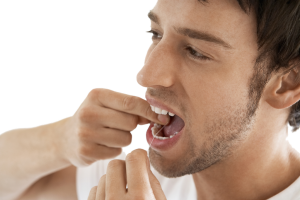
Oral Hygiene for Teenagers
 Oral hygiene for teenagers is the best way for a teenager to maintain a bright healthy smile. They should continue the excellent oral hygiene habits started in early childhood. Maintaining healthy teeth and gums is important for overall health at any age. Teenager’s care a lot about how they look so help your teen understand that bad oral hygiene can lead to stains, bad breath, missing teeth, and many other dental problems.
Oral hygiene for teenagers is the best way for a teenager to maintain a bright healthy smile. They should continue the excellent oral hygiene habits started in early childhood. Maintaining healthy teeth and gums is important for overall health at any age. Teenager’s care a lot about how they look so help your teen understand that bad oral hygiene can lead to stains, bad breath, missing teeth, and many other dental problems.
Brushing and Flossing
Brush twice a day for 2 minutes with an ADA accepted fluoride toothpaste to remove plaque. To prevent cavities, you need to remove plaque, the transparent layer of bacteria that coats the teeth. The best way to do this is by brushing your teeth twice a day and flossing at least once a day. Brushing also stimulates the gums, which helps to keep them healthy and prevent gum disease. Brushing and flossing are the most important things that you can do to keep your teeth and gums healthy Plaque is the main cause of tooth decay and gum disease.
Here are some tips/techniques on proper brushing:
- Hold your brush at a 45-degree angle against your gum line. Gently brush from where the tooth and gum meet to the chewing surface in short (about half-a-tooth-wide) strokes. Brushing too hard can cause receding gums, tooth sensitivity, and, over time, loose teeth.
- Use the same method to brush all outside and inside surfaces of your teeth.
- To clean the chewing surfaces of your teeth, use short sweeping strokes, tipping the bristles into the pits and crevices.
- To clean the inside surfaces of your top and bottom front teeth and gums, hold the brush almost vertical. With back and forth motions, bring the front part of the brush over the teeth and gums.
- Using a forward-sweeping motion, gently brush your tongue and the roof of your mouth to remove the decay-causing bacteria that exist in these places.
- Play a favorite song while brushing your teeth to get used to brushing for a full 2 to 3 minutes. Some electronic toothbrushes have timers that let you know when 2 minutes are up
Teenage Dental Flossing
 Floss daily to remove plaque from between your teeth and under your gum line. If plaque is not removed daily, it can harden into tartar —an unsightly, hard yellow build-up.
Floss daily to remove plaque from between your teeth and under your gum line. If plaque is not removed daily, it can harden into tartar —an unsightly, hard yellow build-up.
About 1 person in 10 has a tendency to accumulate tartar quickly. Tartar is a plaque in a hardened form that is more damaging and difficult to remove. Using anti-tartar toothpaste and mouthwash, as well as spending extra time brushing the teeth near the salivary glands (the inside of the lower front teeth and the outside of the upper back teeth) may slow the development of new tartar. Talk with Dr. Rubin about dental sealants to protect against cavities. The type of floss you choose depends on how much space you have between your teeth. Dentists usually recommend unwaxed floss because it’s thinner and easier to slide through small spaces. However, studies have shown that there is no major difference in the effectiveness based on the type of floss used.
With any floss, you should be careful to avoid injuring your gums. Follow these instructions:
- Carefully insert the floss between two teeth, using a back and forth motion. Gently bring the floss to the gum line, but don’t force it under the gums. Curve the floss around the edge of your tooth in the shape of the letter “C” and slide it up and down the side of each tooth. Repeat this process between all your teeth, and remember to floss the back sides of your back teeth.
- Include a travel-size toothbrush and toothpaste in your gym bag, backpack or locker for use after meals or on the go.
- Maintain a healthy diet rich in fruits and veggies, and low in sweetened foods and drinks. Keep lots of fruits and vegetables in the house for snacking.
- Limit soda and sugary drinks. Sugar found in popular sodas, sports, and energy drinks increases the risk of cavities. In addition, acids found in sodas, including diet sodas may damage the teeth’s enamel, putting teens at increased risk for tooth decay. Keep in mind it’s not just what you put in your mouth that is important, but also how often you are snacking. Each time you eat or drink anything with sugar, it interacts with the bacteria in your mouth, bathing your teeth in acid for about 20 minutes.
- Drink plenty of water. Remember it is important to drink water after eating meals and snacks to clean the teeth of bacteria and food. If you can’t brush your teeth after eating, rinse your mouth with water or mouthwash, or chew sugarless gum.
- Limit between-meal snacks — especially those high in sugar.
- Visit the Frisco Kids Dentistry every 6 months for professional cleanings and checkups.
- Have plenty of oral health-care supplies on hand. Keep soft toothbrushes, colored or flavored floss (or plastic floss picks) and good- tasting toothpaste out in the bathroom. You can even keep them in the kitchen for quick use when teens are in a hurry.
- Avoid tobacco products and mouth jewelry or consider switching to non-metal jewelry.
- Choose mints or gum with xylitol, a natural cavity-fighting sweetener, as the first ingredient
- Check with our office before using any tooth whitening products.
Be sure your kids know that if those pearly whites are to last a lifetime they’re not to be used as ice crushers and bottle openers. In addition to helping teeth last a lifetime, excellent oral care simply makes you feel good. It also gives you fresher breath and a nicer looking smile.
Please contact our office by Online Appointment Request or call 214 618 5200 if you would like to schedule an appointment.
